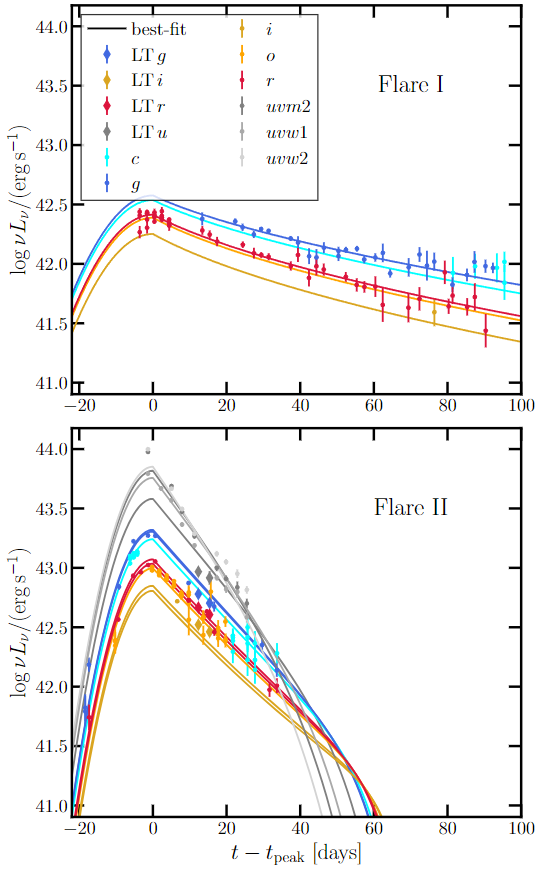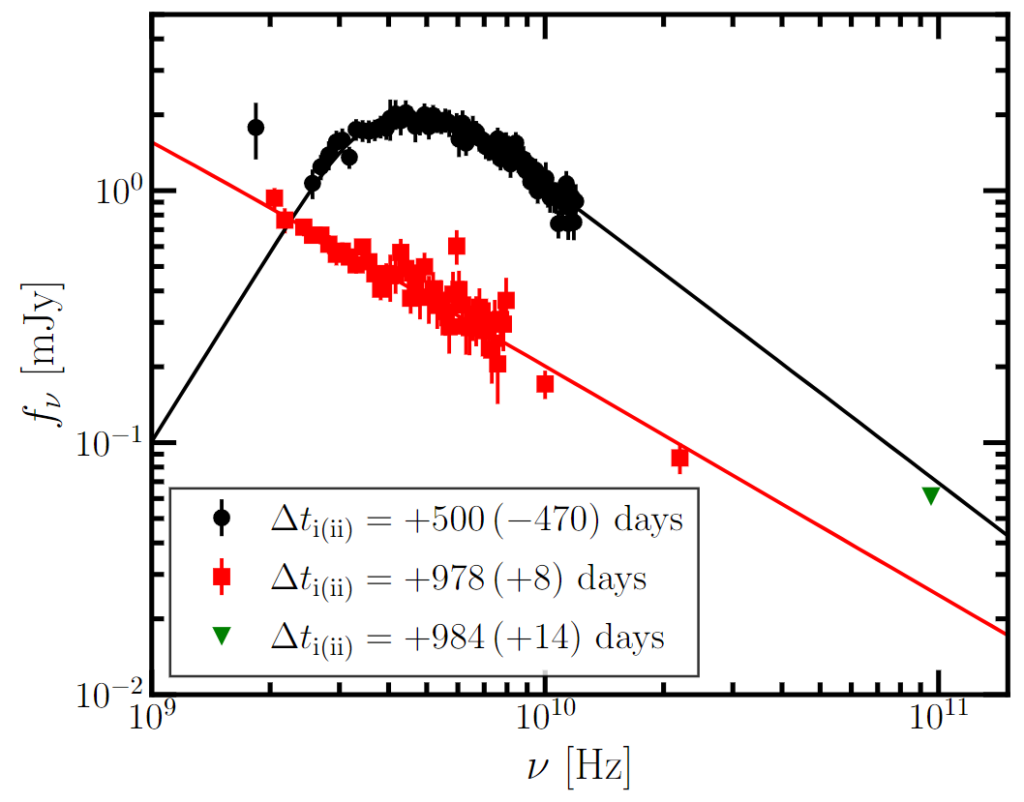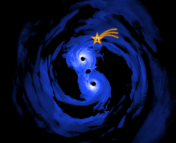Title: The first systematically identified repeating partial tidal disruption event
Authors: Jean J. Somalwar, Vikram Ravi, Yuhan Yao, et al. (13 additional authors)
First Author’s Institution: Cahill Center for Astronomy and Astrophysics, California Institute of Technology
Status: Submitted to the Astrophysical Journal (eprint on arXiv)
Supermassive black holes (SMBHs) are some of the most powerful and enigmatic objects known in the Universe. They contain thousands to billions of times the mass of our Sun compacted into a single point at the center of a galaxy, and yet give off no light at any wavelength which we could use to study them. Despite this, we know they exist by observing the incredible effects they have on their surroundings – bright objects such as quasars are powered by the material orbiting a black hole.
Tidal disruption events (TDEs) are another incredible phenomenon caused by black holes– in this case, the tremendous gravitational pull of the central black hole can rip stars apart, and when that stellar material accretes onto the black hole, it creates a bright flare which can be viewed from radio to X-ray wavelengths (check out these bites!). Not all TDEs are created equal though, and some of these events appear to only shred part of the star, while the remainder is able to survive and continue orbiting the black hole – this is known as a partial TDE, or pTDE. Only a few of these events have been confirmed to be pTDEs through observations of similar flares coming from the same black hole multiple times.
Since TDEs are one of the few ways we can really probe the properties of the central black hole, it’s important to try to separate TDEs and pTDEs, and learn more about their individual mechanisms. But the known pTDEs have been detected by blind luck using different telescopes at both X-ray and optical wavelengths, and that makes it very difficult to answer some very important questions: how many TDE and pTDE events should we be able to detect per year? Which type of event is more common? Are our theoretical models about these objects, and the emission we expect from them, correct? Today’s authors try to bridge that gap by pursuing a systematic search for TDEs at optical wavelengths, and report on the first discovery of a pTDE using such a comprehensive search!
AT 2020vdq: the first systematically identified pTDE

For the past few years, the Zwicky Transient Facility (ZTF) at the Palomar Observatory has scanned the entire Northern sky every two days, which allows for incredibly consistent tracking of transient objects which can change on timescales of days, like TDEs. In October of 2020, a flare coming from a nearby dwarf galaxy was detected by ZTF, and its properties were similar enough to known TDEs that it was labeled as such and named AT 2020vdq. The top panel of Figure 1 shows the light curves, or the brightness as a function of time, of this flare as seen in optical and UV wavelengths.
After 2.6 years of slow but consistent dimming, AT 2020vdq began to brighten once again in May of 2023. Since full TDEs rip an entire star apart, only a partial TDE can explain how the source was able to rebrighten. Once again, optical and UV telescopes around the world were used to monitor this second flare from the source– the bottom panel of Figure 1 shows the light curves of the second flare. There were some notable differences between the two flares: the second flare had a peak luminosity five times higher than that of the first flare, and the light from the flare brightened and dimmed more quickly than almost every TDE that the ZTF has witnessed so far. As this second flare brightened and dimmed, it only took five days for its brightness to double (or get cut in half as it dimmed), unlike most TDEs which take weeks to months for their brightnesses to double/get cut in half. According to our best understanding of pTDEs, the only things that should change in between flares are the structure of the star being ripped apart, and the distribution of material surrounding the SMBH, but we can’t definitively find the specific change responsible for such fast rise and decay times.
In addition to optical and UV observations, the authors took observations at radio wavelengths with the Very Large Array to get a complementary look at the region around the SMBH responsible for the pTDE studied in this paper. Their unexpected results are best represented in Figure 2, which shows the radio spectra of the source at two different times. The spectrum, or brightness as a function of wavelength (frequency in Figure 2), can help us understand what kind of emission processes are taking place at the source, since different emission mechanisms will have different spectral distributions.

There is a clear difference in the spectral properties of this source in these two observations: the black points represent the spectrum 500 days after the first flare (or 470 days before the second), and the red points are from an observation taken 8 days after the second flare. The shape of the spectrum taken between the two flares shows a ‘bump’ indicative of an outflow region– gas flowing away from the SMBH – emitting radio waves. However, right after the second flare, the signature of this outflow disappeared. Right now, we can only speculate about why this outflow could have disappeared between the two observations: perhaps something changed in the accretion disk surrounding the black hole which stopped it from launching these outflows, or the interaction between the star and the disk stopped the outflow.
Overall, even this singular TDE event presents a few mysteries which will take further observations to solve. Aside from the fast rise and decay times, the properties of this partial TDE (total brightness, implied temperature, spectral lines, etc.) were strikingly similar to the bulk population of full TDEs– so, many of the events we call TDEs could have actually only been partial TDEs which we’ve never seen repeat. Continuous observations with the ZTF will help us distinguish between the two, as it will quickly catch rebrightening events from other TDEs. In fact, while analyzing follow-up observations on all of the known TDE events, the authors saw a bright flare from the location of a known TDE, but it turned out to be a completely unrelated supernova in the same galaxy! Clearly, the power of consistent observations and deep searches of the night sky will reveal many interesting and exciting transient events.
Edited by Sarah Bodansky
Featured image credit: NASA/CXC/M. Weiss




